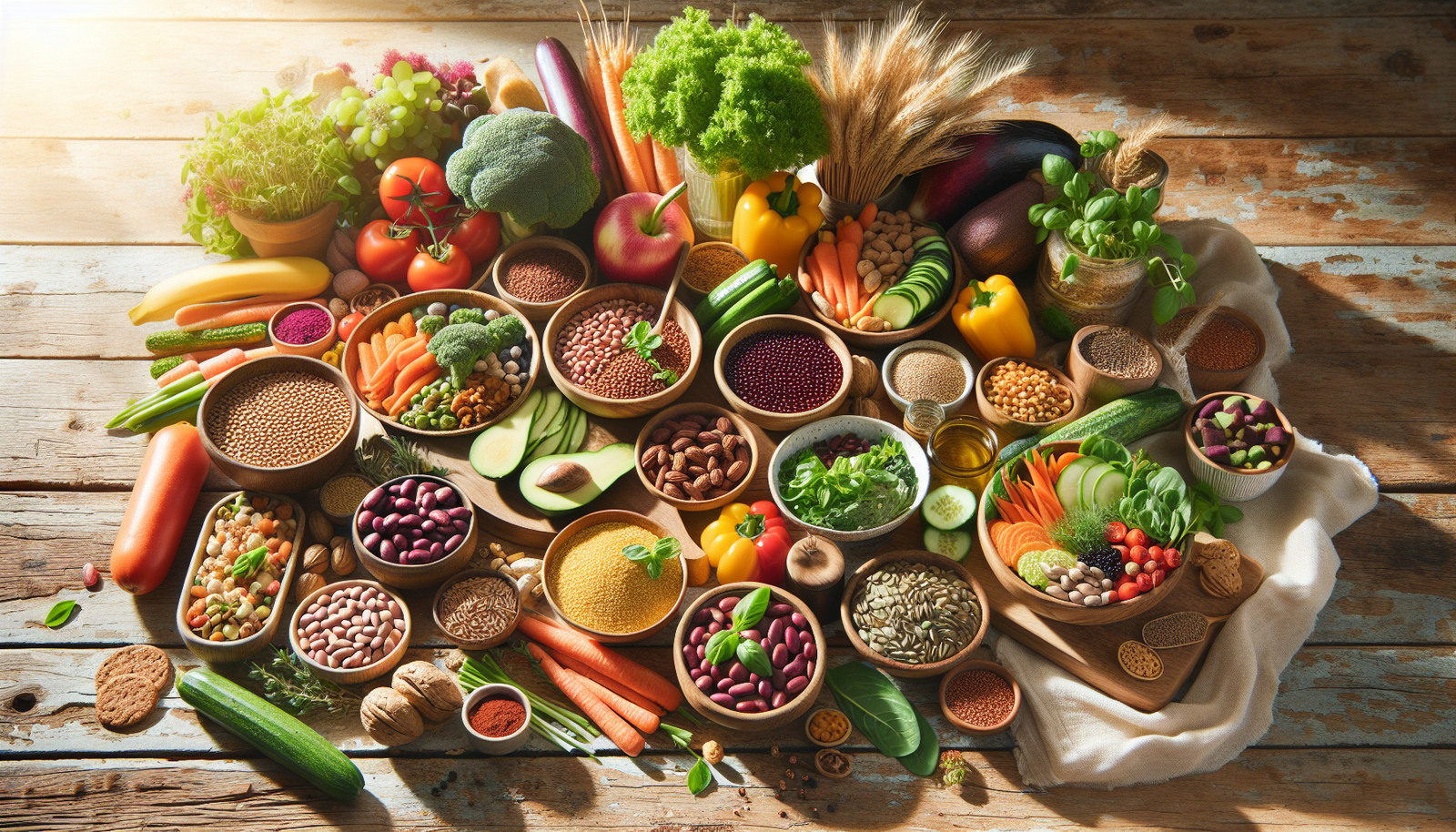
How to Plan Balanced Meals Without Dairy: A Complete Guide
Plan balanced dairy-free meals to maintain optimal nutrition without relying on dairy products. With over 65% of the global population experiencing some form of lactose intolerance, finding alternative sources of calcium and vitamins is crucial. This guide provides strategies to incorporate nutrient-rich options while ensuring dietary needs are met. From plant-based sources like almonds and leafy greens to fortified cereals, learn how to diversify your plate. Equip yourself with meal ideas and expert tips for achieving nutritional balance without the need for dairy.
Understanding Dairy-Free Nutrition
Exploring the world of dairy-free nutrition opens the door to diverse and exciting food choices. This journey goes beyond just removing dairy; it involves embracing a wide array of nutrient-dense foods that support overall well-being. Let’s dive into the essentials of dairy-free nutrition and discover how to maintain a balanced diet without dairy products.
The Importance of Plant-Based Calcium Sources
Calcium is vital for bone health, but many associate it solely with dairy products. Fortunately, several plant-based sources offer ample calcium, helping those on a dairy-free diet maintain strong bones and teeth.
- Leafy Greens: Kale, bok choy, and collard greens are excellent sources of calcium. Incorporate them into salads, smoothies, or stir-fries for a nutrient boost.
- Nuts and Seeds: Almonds and sesame seeds, particularly in the form of tahini, are rich in calcium. Snack on them or add them to dishes for added crunch and nutrition.
- Fortified Foods: Many plant-based milks and orange juices are fortified with calcium. Check labels to ensure you’re getting a sufficient amount.
- Tofu and Tempeh: These soy-based foods not only provide calcium but are also excellent protein sources.
Incorporating these foods ensures you get the calcium needed for healthy bones without relying on dairy.
Essential Vitamins and Minerals in Dairy-Free Diets
A dairy-free diet can be rich in essential vitamins and minerals if approached thoughtfully. Besides calcium, focus on nutrients that can sometimes be lacking.
- Vitamin D: Often associated with dairy, you can find it in fortified plant milks and cereals. Sunlight exposure also helps boost vitamin D levels.
- Vitamin B12: Crucial for nerve function, it’s primarily found in animal products. Look for fortified foods or consider supplements if necessary.
- Iron: Essential for blood health, iron can be sourced from legumes, lentils, and fortified grains. Pair iron-rich foods with vitamin C sources for better absorption.
- Omega-3 Fatty Acids: Found in flaxseeds, chia seeds, and walnuts, these are important for heart and brain health.
Being mindful of these nutrients ensures a well-rounded, dairy-free diet that meets your nutritional needs.
Protein Alternatives for Dairy-Free Eaters
Protein is another critical component of a balanced diet. Dairy often contributes significantly to daily protein intake, so finding alternatives is key.
- Legumes and Pulses: Beans, lentils, and chickpeas are protein powerhouses. Use them in soups, stews, and salads.
- Nuts and Seeds: Besides calcium, these also provide an excellent source of protein. Include them in your breakfast cereals or as a quick snack.
- Quinoa and Buckwheat: These whole grains are high in protein and make great bases for salads and bowls.
- Meat Alternatives: Tempeh, seitan, and plant-based meat substitutes offer versatile options for meals.
Elevate your protein intake with these dairy-free options, ensuring your diet remains balanced and fulfilling.
Creating a Balanced Dairy-Free Meal Plan
Crafting a balanced meal plan without dairy involves a creative approach to food choices. Focusing on nutrient-rich foods ensures that your diet is both satisfying and nourishing. Here’s how to create meals that support your health and taste delicious.
Incorporating Whole Grains and Legumes
Whole grains and legumes are vital components of any meal plan, offering a rich source of fiber, vitamins, and proteins.
- Oats and Barley: Start your day with a bowl of oatmeal or include barley in soups and salads for sustained energy.
- Brown Rice and Quinoa: These grains are versatile and can be paired with various vegetables and proteins for hearty meals.
- Lentils and Chickpeas: Use these legumes in curries, stews, or as a base for veggie burgers.
- Black Beans and Kidney Beans: Perfect for chili dishes, salads, or as a side, these legumes are both filling and nutritious.
These foods enhance your meal plan by providing essential nutrients and delicious flavors.
Choosing Healthy Dairy-Free Fats
Fats are an essential part of any diet, and there are plenty of dairy-free options to choose from.
- Avocados: Rich in monounsaturated fats, they are perfect for salads, toasts, or smoothies.
- Coconut Products: Coconut oil and milk add flavor and healthy fats to many dishes, from curries to baked goods.
- Olive Oil: A staple in Mediterranean diets, it’s ideal for cooking or as a salad dressing.
- Nuts and Nut Butters: Almonds, cashews, and their butters provide healthy fats and are perfect for snacks or meal additions.
Incorporating these fats ensures you’re getting necessary nutrients while keeping meals tasty and satisfying.
Balancing Macronutrients in Your Daily Meals
Balancing macronutrients—proteins, fats, and carbohydrates—is crucial for maintaining energy and health. Striking the right balance in your meals is easier than you might think.
- Proteins: Ensure each meal has a protein source like legumes, tofu, or nuts to support muscle health and satiety.
- Fats: Include healthy fats from sources like olive oil or avocado to help absorb vitamins and keep you satisfied.
- Carbohydrates: Opt for complex carbs such as whole grains and vegetables for sustained energy.
- Portion Control: Use a balanced plate method—half veggies, a quarter protein, and a quarter grains—to keep meals in check.
Focusing on balance helps maintain health and energy throughout the day while enjoying delicious meals.
Practical Tips for a Dairy-Free Lifestyle
Adopting a dairy-free lifestyle involves more than just dietary changes. It requires a mindful approach to food choices and cooking methods. Here are practical tips to help you navigate this lifestyle smoothly and enjoyably.
Reading Food Labels for Hidden Dairy Ingredients
Identifying hidden dairy ingredients is crucial for maintaining a dairy-free diet. Many processed foods contain dairy, so it’s essential to read labels carefully.
- Common Dairy Ingredients: Look for terms like whey, casein, lactose, and milk solids, which indicate dairy presence.
- Allergy Warnings: Check for “may contain” statements that highlight potential cross-contamination with dairy.
- Vegan Labels: Products labeled as vegan are usually free of dairy, but double-check ingredients to be sure.
- Product Knowledge: Familiarize yourself with brands that specialize in dairy-free products for safer choices.
Being vigilant about labels helps you avoid accidental dairy consumption and maintain your dietary goals.
Delicious Dairy-Free Cooking Techniques
Dairy-free cooking can be flavorful and exciting with the right techniques and ingredients. Explore new culinary horizons with these tips:
- Flavor Boosters: Use herbs and spices like basil, cumin, and smoked paprika to enhance dishes without dairy.
- Alternative Milks: Almond, soy, and oat milk are great for cooking and baking, offering different flavors and consistencies.
- Thickening Agents: Use cornstarch or arrowroot powder to thicken sauces and soups instead of cream.
- Cheese Replacements: Nutritional yeast offers a cheesy flavor while being entirely dairy-free.
These techniques make dairy-free cooking both delicious and versatile, opening up a world of culinary possibilities.
Quick and Easy Dairy-Free Snack Ideas
Snacking on a dairy-free diet doesn’t have to be challenging. Plenty of quick and delicious options are available to satisfy your cravings.
- Fruit and Nut Mixes: Combine your favorite dried fruits with nuts for a nutrient-dense snack.
- Veggies and Hummus: Carrot sticks or cucumber slices with hummus make a refreshing and satisfying snack.
- Rice Cakes with Nut Butter: Top rice cakes with almond or peanut butter for
Conclusion
A balanced dairy-free meal plan focuses on incorporating a variety of nutrient-dense foods. These include fruits, vegetables, whole grains, lean proteins, and healthy fats. Calcium and vitamin D intake should be prioritized through plant-based sources like fortified plant milks, tofu, and leafy greens. It’s essential to read labels for hidden dairy ingredients and opt for dairy alternatives like almond, soy, or oat milk. Regularly varying food choices ensures a broad spectrum of nutrients for optimal health.
FAQ
What are some nutritious dairy-free meal ideas for a balanced diet?
Explore a variety of flavorful meals like quinoa salad with roasted vegetables, chickpea curry, or tofu stir-fry. Consider whole grains, legumes, and colorful veggies to create diverse and satisfying dishes. Incorporating nuts, seeds, and fruits ensures a nutrient-rich plate.
How can I ensure adequate calcium intake in a dairy-free meal plan?
Focus on calcium-rich foods like fortified plant milks, leafy greens, broccoli, almonds, and tofu. These options can help maintain strong bones and overall health. Consider calcium-fortified cereals and juices for added variety.
What are the best plant-based milk alternatives for a dairy-free diet?
Options like almond, soy, oat, and coconut milk offer great dairy-free alternatives. Each type has a unique taste and nutrient profile, catering to different preferences and dietary needs. Choose unsweetened versions to minimize added sugars.
How can I incorporate protein into a dairy-free meal plan?
Beans, lentils, quinoa, tofu, tempeh, and nuts are excellent protein sources. Integrating these into meals ensures a well-rounded diet. Explore diverse recipes and experiment with spices to keep meals exciting and protein-rich.
What are common dairy-free sources of vitamin D for a balanced diet?
Fortified plant milks, mushrooms, and exposure to sunlight can help maintain vitamin D levels. Vitamin D supplements can also support nutritional needs, especially during months with limited sun exposure.
How do I plan a dairy-free meal plan that meets daily nutritional needs?
Begin by setting meal goals and incorporating a variety of food groups. Balance proteins, grains, and colorful vegetables. Monitor nutrients like calcium and vitamin D, using fortified products when necessary. Consistent planning and mindful eating ensure a balanced diet.











